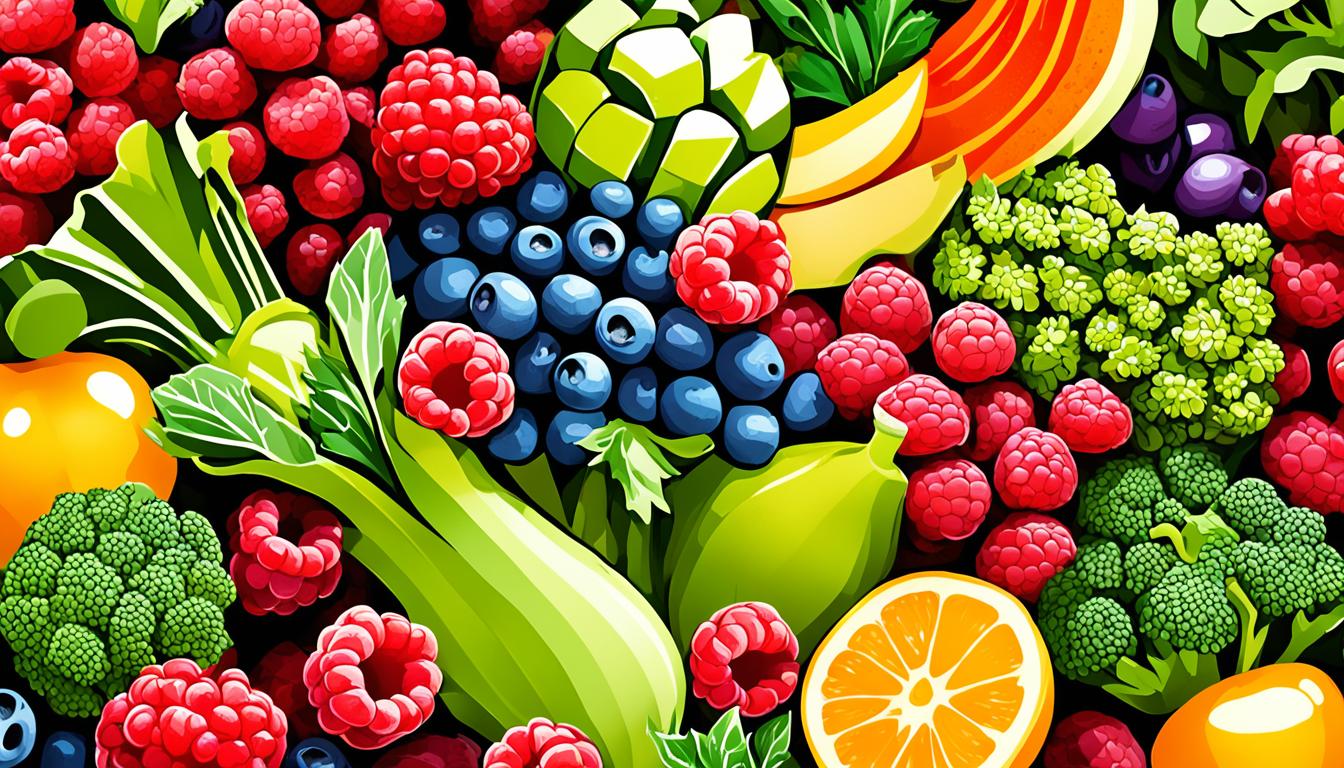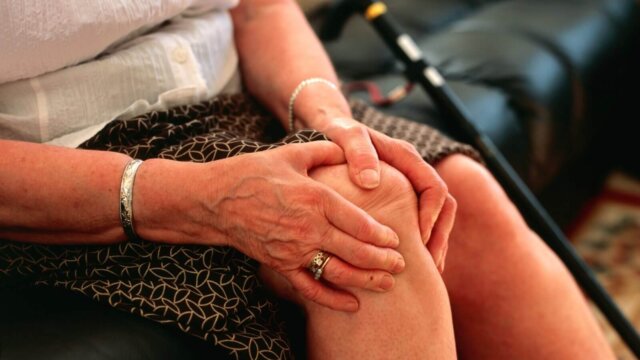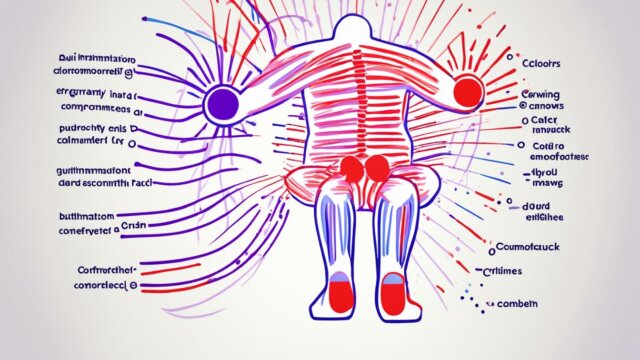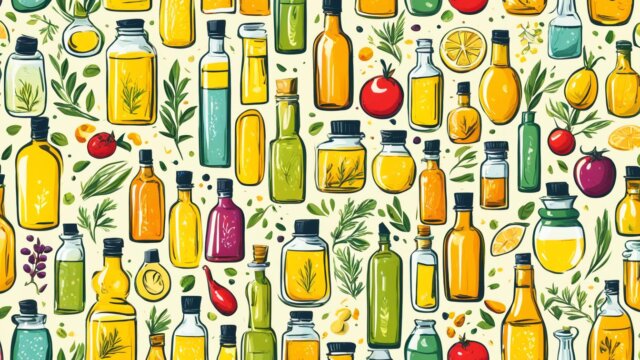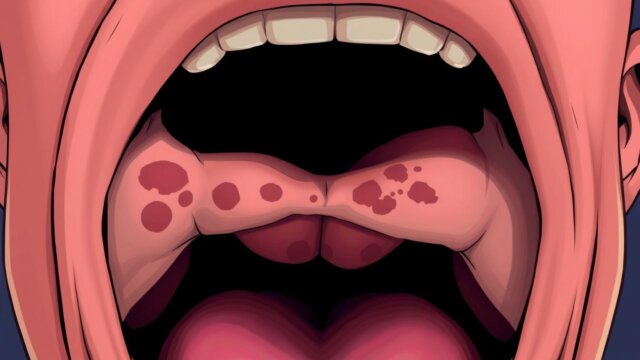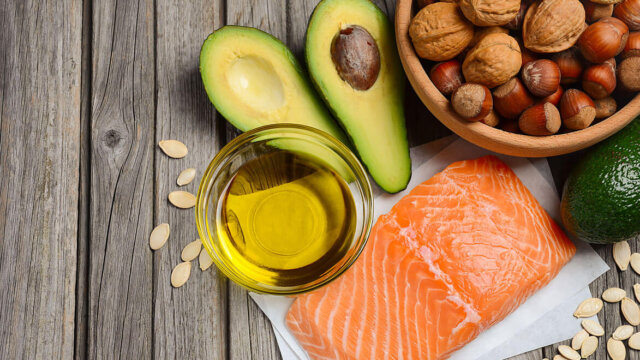FTC disclaimer: This post may contains affiliate links and we will be compensated if you click on a link and make a purchase.
A cup of kidney beans gives you a lot of daily fiber, maybe even over a third. Fiber helps a lot with losing weight. It makes you feel full and cuts down on how much you eat. The Academy of Nutrition and Dietetics suggests getting 14 grams of fiber for every 1,000 calories you eat each day.
But, most people in the U.S. get only about 15 grams, which is not enough. Adding high-fiber foods to what you eat can really help you lose those extra pounds.
Key Takeaways
- Fiber-rich foods can help with weight loss by promoting feelings of fullness and reducing calorie intake.
- The recommended daily fiber intake is about 14 grams per 1,000 calories consumed, but most Americans only consume half that amount.
- High-fiber foods include fruits, vegetables, legumes, whole grains, nuts, and seeds.
- Incorporating more fiber-rich foods into your diet can be a effective strategy for weight management.
- Gradually increasing your fiber intake is important to avoid digestive discomfort.
Introduction to Fiber-Rich Foods for Weight Loss
Weight loss isn’t the same for everyone. But, research shows adding high-fiber foods helps. Fiber is key in keeping us healthy, from our gut to our blood sugar and cholesterol levels.
Most of us don’t get enough fiber daily. This includes 90% of women and 97% of men. Getting enough fiber is vital for its great effects, like helping with weight loss.
In this section, we’ll dive into fiber-rich foods and how they fit into your diet for weight control. Knowing about various fibers and their roles can help you choose well. This choice positively affects your health.
“Fiber intake predicts weight loss and dietary adherence in adults consuming calorie-restricted diets: the POUNDS lost study” showed a correlation between fiber intake and weight loss.
Using a variety of fiber-rich foods is powerful, but there’s no magic pill for weight loss. A high-fiber diet is a useful part of your plan. It helps you tackle your health from all angles for a better life.
What is Dietary Fiber and Its Types?
Dietary fiber is a type of carbohydrate that our body can’t break down. It was once simply known as the part of plants our body couldn’t digest. But now, we know some digestible things are also like fiber. We find it in fruits, veggies, whole grains, and legumes naturally. But, there’s also added fiber in some foods.
Soluble fiber and insoluble fiber are the two main types. Knowing about these can help you make good choices for your health and weight.
Soluble Fiber
Soluble fiber mixes with water to form a gel. Foods like oats, peas, and apples are rich in this type. It helps slow down the way your body takes in sugar and bad cholesterol. This can help with weight and keep your heart healthy.
Insoluble Fiber
Unlike soluble fiber, insoluble fiber doesn’t mix with water. It helps move waste through your gut better and also makes your stool bulkier. You’ll find it in wheat products, nuts, and veggies like cauliflower. It’s great for a healthy gut and fights constipation.
Eating foods high in both soluble and insoluble fibers is great for your health and can help with weight control.
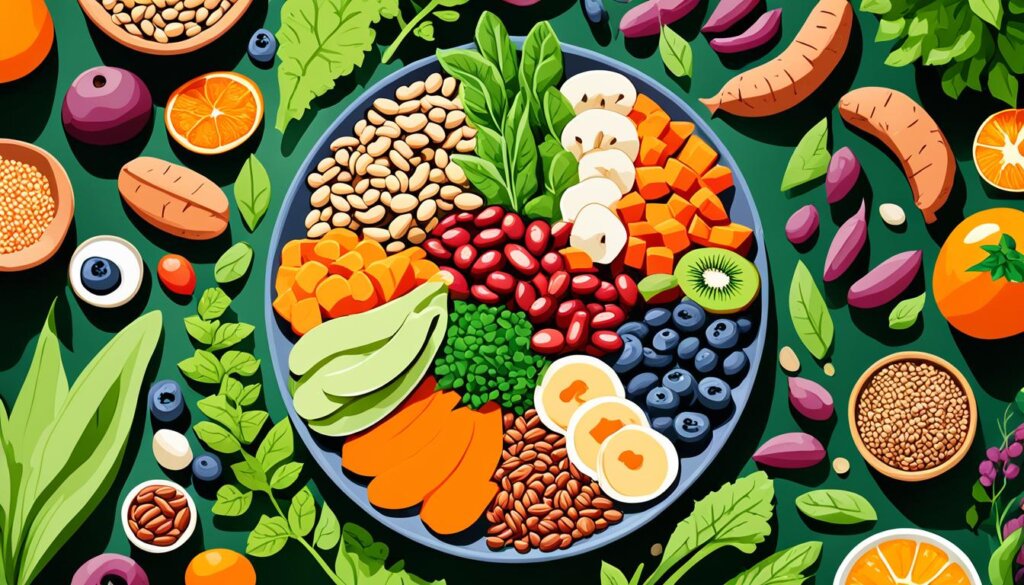
“Eating a diet high in fiber is associated with a reduced risk of several chronic diseases, including heart disease, type 2 diabetes, and certain types of cancer.”
Fiber needs change with age and if you’re a man or a woman. Those under 50 should aim for 38 grams a day if they’re men, and 25 grams if they’re women. If you’re 51 or older, 30 grams for men and 21 grams for women is enough. But, only 5% of Americans get the right amount of fiber. The average American only takes in about half the needed fiber each day.
Getting to know different types of fiber and adding a range of fiber-rich foods to your meals is a big step towards better health. It also helps with watching your weight.
Benefits of Eating Fiber-Rich Foods
Eating foods high in fiber is good for you. It helps with your health and managing your weight. Fiber is key for lowering cholesterol, keeping a healthy weight, and avoiding constipation.
Fiber slows down how fast you digest food. That means you feel full longer. It’s great for staying a healthy weight because it keeps your energy steady and stops cravings. It helps keep your blood sugar level, which is important for energy and weight loss efforts.
Fiber makes your stomach and intestines work better by adding bulk. This helps fight constipation and makes you less bloated. Certain fibers, like in apples, can even help prevent cancer.|
But, most Americans eat too little fiber. People should eat 25 to 38 grams of fiber every day. That’s what health experts say. Fiber is really important for your health and wellness.
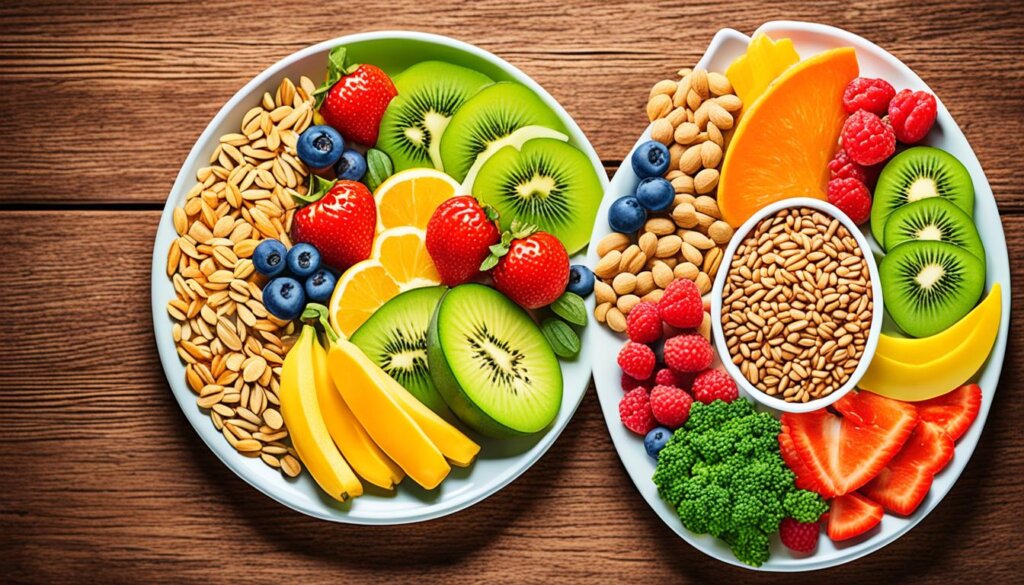
Try to eat lots of different high-fiber foods. It’s great for your health and helps you keep a good weight.
High-Fiber Fruits for Weight Loss
Fruits are great for those trying to lose weight because they’re full of fiber. Raspberries, pears, and apples are top choices. They have lots of fiber and also give you vitamins, minerals, and antioxidants for good health.
Raspberries
Raspberries are packed with fiber, 8 grams in just one cup. They also have vitamin C, manganese, and antioxidants. Adding raspberries to your meals is a smart way to eat more fiber and meet your weight loss aims.
Pears
Pears not only taste great but also have lots of fiber. One medium raw pear has about 5.5 grams of it. This fiber helps you feel full, which is good for weight management. Plus, pears have vitamins, minerals, and antioxidants that help keep you healthy.
Apples
Apples help you feel satisfied and they have both soluble and insoluble fiber. A medium apple gives you 4.4 grams of fiber, which is very good. The fiber in apples slows down sugar absorption, making them ideal for those watching their weight. Apples are also full of vitamins, minerals, and plant nutrients that are good for you in many ways.
Blueberries, blackberries, bananas, and avocados are also high in fiber. Including these fruits in your diet helps you get more fiber, which can aid in losing weight.

Fiber-Rich Vegetables for Weight Management
Vegetables are great for managing your weight. They are full of fiber that makes you feel full without too many calories.
Foods like broccoli, Brussels sprouts, and carrots are high in fiber. They offer from 2 to 9.6 grams for every serving. For example, broccoli gives you 2.4 grams of fiber in each cup. On the other hand, Brussels sprouts have a big 4.5 grams for each cup when cooked.
Carrots also have a good amount of fiber, with 2.8 grams in every 100 grams. Beets are not far off, giving you 2 grams of fiber for the same amount.
Artichokes lead the pack with an impressive 9.6 grams in just one medium-sized veggie. Adding these vegetables to your meals will help you feel full and happy. This can mean eating fewer calories and helping you reach your weight goals.
Vegetable | Fiber Content | Calories |
|---|---|---|
Broccoli | 2.4 g per cup | 62 calories per cup |
Brussels Sprouts | 4.5 g per cup cooked | – |
Carrots | 2.8 g per 100 g | – |
Beets | 2 g per 100 g | – |
Artichokes | 9.6 g per medium | 89 calories per medium |
Using these fiber-packed veggies can really boost your weight management. Their fiber helps you feel full, which may cut down on how much you eat. This supports not just weight goals but also your health and well-being overall.
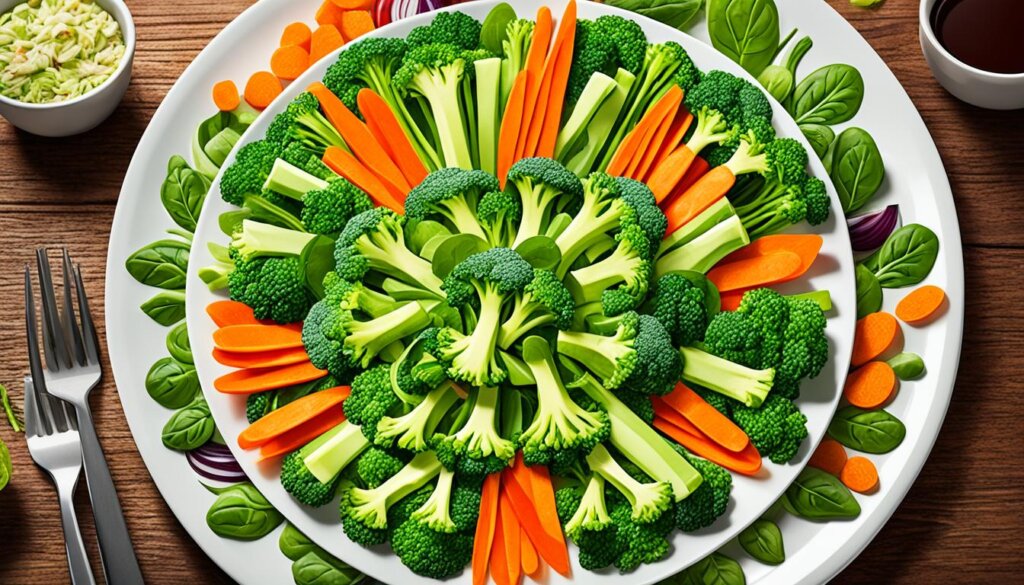
Eating a balanced diet that includes lots of fiber-rich vegetables is key for managing your weight. So, aim to have these vegetables often. They will make your meals healthier and more filling.
High-Fiber Legumes and Beans
Legumes and beans are great for those looking to lose weight. They are filled with fiber. So, you get full without eating too many calories. Plus, they have protein, complex carbs, and lots of vitamins and minerals.
Lentils are one of the best choices. A half-cup of cooked lentils gives you 7.8 grams of fiber. That’s 23.5% of what you need in a day. Kidney beans are good too. With 7.4 grams of fiber in a half-cup, they give you 26.8% of your daily fiber needs.
Chickpeas, or garbanzo beans, also have a lot of fiber. A half-cup has 7 grams, meeting 19% of your daily need. You can also enjoy black beans, lima beans, edamame, and baked beans. They are all good for diets aimed at losing weight.
These foods help you feel full and support weight loss. They’re not just high in fiber but also in protein. This combo helps with your diet goals by keeping you satisfied and aiding digestion.
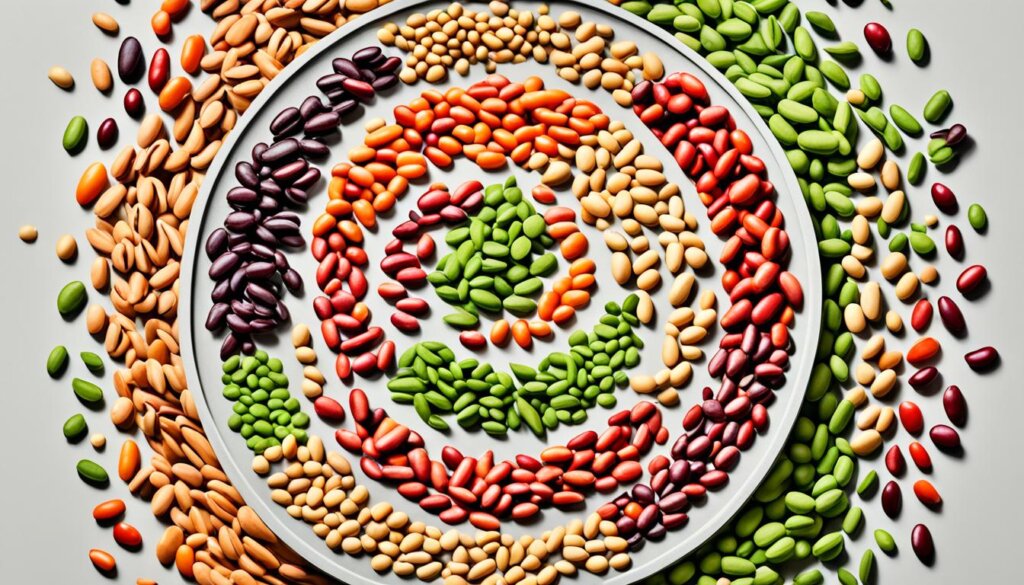
“Legumes are a nutritious and versatile ingredient that can be easily incorporated into a wide variety of dishes, from soups and stews to salads and side dishes. Their high fiber content and protein-rich profile make them an excellent choice for anyone looking to lose weight and improve their overall health.”
Whole Grains: A Source of Dietary Fiber
Whole grains are great for your weight loss journey. They make you feel full with fewer calories thanks to their high fiber content. Oats and quinoa are top picks for this because they are full of essential nutrients.
Oats
Oats are great for adding fiber to your diet. In a 100-gram serving, they have 10.1 grams of fiber. This fiber, beta-glucan, helps with blood sugar and cholesterol. It’s easy to include oats in your meals, like in oatmeal, to help manage your weight.
Quinoa
Quinoa is a pseudo-cereal that’s packed with fiber. It has 2.8 grams of fiber in a 100-gram serving. It’s also a full protein and has important minerals. Adding quinoa to salads or as a side is a tasty way to get more fiber and support your health.
Barley, bulgur, and whole grain products like bread and pasta are also rich in fiber. Adding these to your meals regularly can make a big difference in your weight loss efforts and overall health.
“Whole grains are a great source of dietary fiber that can support weight loss. Incorporating these fiber-rich whole grains into your diet can help you feel fuller on fewer calories.”
The secret to managing your weight well is not just eating fewer calories but choosing foods that are rich in nutrients. Whole grains keep you full and satisfied. They also provide energy throughout the day. Making whole grains a big part of your diet is a smart move for a healthier journey.
Fiber rich foods for weight loss: Nuts and Seeds
Fiber-rich foods are key for losing weight. Nuts and seeds stand out in this group because they’re packed with nutrients. They keep you full and bring lots of vitamins, minerals, and healthy fats to your diet.
Almonds
Almonds are great for weight management, with 13.3 grams of fiber in every 100 grams. They are full of fiber, protein, and good fats, making them a filling snack. Adding almonds to what you eat daily is an easy way to eat more fiber and maybe lose weight.
Flax Seeds
Flax seeds are another excellent source of fiber, offering 5.6 grams in just two tablespoons. They’re small but mighty, perfect for adding to smoothies or baked goods. With their fiber, healthy fats, and plant protein, flax seeds help with any weight loss plan.
Other nuts and seeds good for weight loss include chia, pumpkin seeds, and pistachios. They are versatile and dense in nutrients, making them perfect for upping your fiber and reaching your weight loss goals.
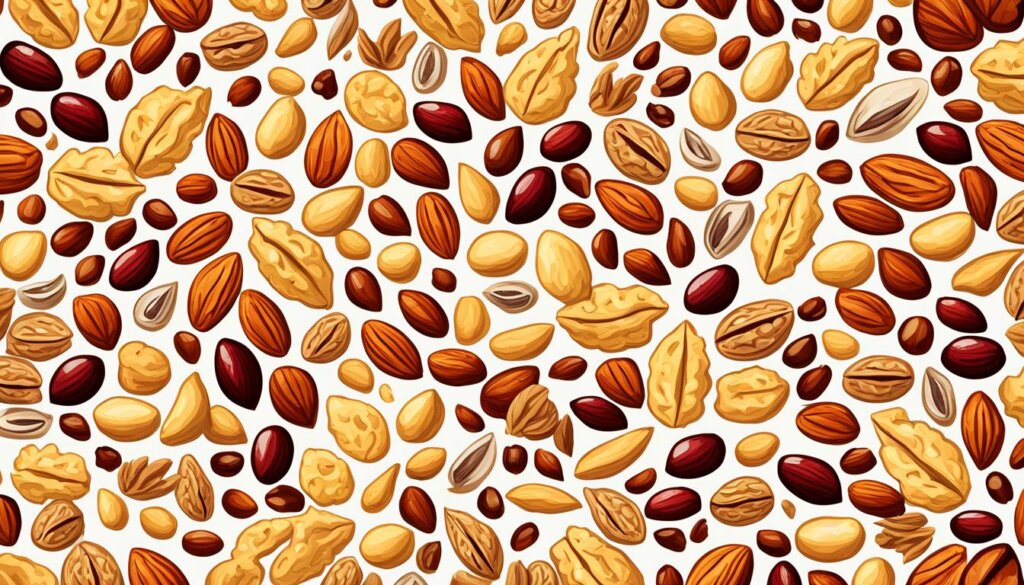
“Fiber-rich nuts and seeds are a game-changer when it comes to weight loss. They keep you feeling full and satisfied, while also providing essential nutrients to support overall health.”
Recommended Daily Fiber Intake
Fiber is key to staying healthy and aiding weight loss. Amounts we need can change with age and if we’re male or female.
The Dietary Guidelines for Americans advise women 19 to 50 to aim for 25 to 28 grams of fiber daily. Men should try to get 30 to 38 grams in the same age range. Kids should have less, like 14 grams for those 1 to 3 years old. The amount goes up as they grow, reaching 30.8 grams for teens 14 to 18. But on average, Americans only get about 16 grams a day.
Even though getting enough fiber might seem tough, it’s worth it. Fiber can help with losing weight. It makes you feel full, cuts how many calories you eat, and keeps your stomach happy. Plus, it’s good for your heart and helps control blood sugar, lowering your risk of certain diseases. A fiber-rich diet also keeps your gut healthy.
Age and Gender | Recommended Fiber Intake (grams per day) |
|---|---|
Women 19-50 years | 25 to 28 grams |
Men 19-50 years | 30 to 38 grams |
Children 1-3 years | 14 grams |
Children 4-8 years | 19.6 grams |
Teenagers 14-18 years | 30.8 grams |
Fiber supplements can be handy, but they don’t beat real high-fiber foods. Try to eat lots of fruits, veggies, whole grains, beans, and nuts. This is the best path to meeting your daily fiber goal and losing weight.
Always talk to your doctor to set the right fiber amount for you. They will make sure you have a diet that’s both healthy and enjoyable.
Tips for Increasing Fiber Intake Gradually
If you want to up your fiber for weight loss, take it slow. Adding too much fiber to your diet fast can cause issues like gas and diarrhea. So, start slowly and build up your fiber over time.
First, switch to whole grains. Choose foods like whole-wheat bread and brown rice over the white versions. Also, enjoy snacks such as fruits and vegetables. Apples, pears, raspberries, and carrots are excellent choices.
- Try to add 2-3 grams of fiber to your daily diet gradually.
- Don’t forget to drink lots of water with extra fiber to keep your digestion smooth.
- Move more with activities like walking or yoga to help your body get used to more fiber.
Adding chia, flax, or hemp seeds to meals is another great idea. These seeds are full of fiber and can be an easy addition to your day. Top oatmeal, yogurt, or desserts with them.
Being patient and sticking to your plan is important when going high-fiber. Keep it up, and you will enjoy the advantages of a fiber-filled diet. That’s less hunger and more weight loss.
“Incorporating more fiber-rich foods into your diet is one of the best ways to support your weight-loss journey. The key is to do it gradually and stay hydrated.”
Low-Fiber Foods to Limit
Focusing on eating more high-fiber foods helps with losing weight. It’s also critical to watch out for low-fiber foods. These include meat, fish, dairy, eggs, as well as egg, and white bread, white rice, and pastries. They can add extra calories without the good stuff that high-fiber foods give.
A diet low in fiber means you eat about 10 grams of fiber a day. Doctors might suggest this for people with certain health problems. These include issues like narrowing of the bowel, Crohn’s disease, and preparation for surgeries. But, cutting out fiber long-term might lead to not getting enough nutrients. So, talking to a dietitian is smart.
On a low-fiber diet, avoid nuts, seeds, dried fruits, whole grains, popcorn, and legumes like beans and lentils. You should choose foods that are easy to digest. This includes tender meats, white rice, foods made from refined grains, well-cooked veggies, and some fruits like bananas and melons.
Even though low-fiber foods might be right for some health needs, they’re not as good for you as high-fiber ones. By eating less low fiber foods, processed items, and refined grains, you can get the fiber your body needs. This also helps with losing weight.
“A low-fiber diet may result in reduced bowel movements and smaller stools, potentially easing symptoms like diarrhea or stomach pain.”
It’s important to balance the good things about fiber-rich foods and when a low-fiber diet is necessary. Knowing what kind of foods to limit helps you make good health choices. This can help you manage your weight and stay healthy.
The Role of Fiber in Weight Management
Eating enough fiber is key for managing our weight because it affects our body in many ways. Foods rich in fiber make us feel full easier. This means we need fewer calories to feel satisfied. Fiber slows how fast we digest food. This keeps us feeling full longer and helps stop us from eating too much. Also, it keeps our blood sugar steady. This stops us from feeling super hungry and wanting to snack a lot.
Many studies have shown eating lots of fiber helps with weight loss. For example, a study in 2015 found that eating 30g of fiber a day can help you lose a lot of weight. A diet high in fiber makes you feel less hungry and more full.
Soluble fiber, like what you find in apricots, beans, and oats, is especially good at making you feel less hungry and helping you lose weight.
Fiber is found in foods that are low in calories but full of good nutrients. This makes them great for losing weight. Eating a lot of fiber lowers your risk for heart disease, stroke, diabetes, and cancer. Foods with fiber include fruits, veggies, whole grains, nuts, seeds, and beans. These also offer a lot of health benefits.
Adding fiber to your diet with supplements or in enriched foods helps, but it’s not the same as eating the real thing. To really get all the good stuff from fiber, you should eat whole, fiber-rich foods. And don’t forget to drink enough water to help avoid any tummy issues.
Choosing foods high in fiber is a smart way to take care of your weight and health. Fiber helps you feel full, keeps your blood sugar steady, and gives you important nutrients. It’s a friend in your journey to manage weight.
Benefit of Fiber for Weight Management | Explanation |
|---|---|
Increased Satiety | Fiber-rich foods are more filling, helping you feel full on fewer calories. The fiber slows the digestive process, prolonging feelings of fullness and curbing appetite. |
Blood Sugar Regulation | Fiber helps prevent blood sugar spikes and crashes, which can trigger hunger and cravings. |
Calorie-Burning Effect | Certain types of fiber may have a small, positive impact on metabolic rate, leading to increased calorie burn. |
Reduced Risk of Chronic Diseases | A high-fiber diet is linked to a lower risk of heart disease, stroke, type 2 diabetes, and certain types of cancer. |
As we close, remember that adding fiber to your diet is great for keeping healthy and losing weight. It makes you feel full, keeps your blood sugar steady, and provides vital nutrients. Fiber helps with both your health and weight goals.
Conclusion
Adding fiber-rich foods to your meals can help with losing weight. Things like fruits, veggies, legumes, and more are full of good stuff. They help you feel full and keep your blood sugar steady. By eating more of these, you can not only reach your fiber goals but also help manage your weight better.
Eating more fiber is easy with just a bit of planning. Fiber-rich foods are great for losing weight and keeping your tummy happy. Learn about the benefits of fiber. Then, add different high-fiber foods to what you eat every day. This way, you make the most of fiber to help you with your weight goals.
Changing what you eat in a lasting way is vital. Use the power of fiber foods wisely. Also, have real goals and watch how you’re doing. With effort and the right plan, you can have more fiber in your food. This will be really good for your weight, health, and how you feel every day.
FAQ
What are the benefits of dietary fiber for weight loss?
A: Fiber helps with weight loss in several ways. Foods rich in fiber keep you feeling full longer but with fewer calories. They also help keep blood sugar levels stable, which stops sudden hunger.
This way of eating might also slightly boost how many calories your body burns.
What are the different types of dietary fiber?
Fiber is either soluble or insoluble. Soluble fiber dissolves in water and can be broken down by the body. It mainly comes from fruits, veggies, oats, and barley.
Insoluble fiber does not dissolve. It comes from the outer parts of plants and goes through your body unchanged.
What are some high-fiber fruits that can support weight loss?
For a fiber boost, enjoy raspberries, pears, and apples. A cup of raspberries has 8 grams of fiber. A medium pear supplies 5.5 grams. An apple has 4.4 grams of fiber.
What are some high-fiber vegetables that can aid in weight management?
Vegetables like broccoli, Brussels sprouts, and carrots are great for weight management. A cup of broccoli adds 2.4 grams of fiber. Brussels sprouts give you 4.5 grams per cooked cup.
Carrots and beets help too; they provide 2.8 and 2 grams of fiber for 100 grams. A medium artichoke offers 9.6 grams of fiber.
What high-fiber legumes and beans can support weight loss?
Lentils, kidney beans, and chickpeas are high in fiber. Half a cup of lentils cooked brings 7.8 grams of fiber. Kidney beans cooked in the same amount have 7.4 grams.
Chickpeas add 7 grams of fiber to your dish when cooked.
What whole grains are good sources of dietary fiber?
Oats lead with 10.1 grams of fiber per 100 grams. Quinoa follows with 2.8 grams. Then there’s barley, bulgur, and whole wheat breads and pastas.
What are some high-fiber nuts and seeds that can aid in weight loss?
Almonds are a top pick, with 13.3 grams of fiber per 100 grams. Flax seeds are next at 5.6 grams in a 2 tablespoon serving. Chia seeds, pumpkin seeds, and pistachios are also high in fiber.
What are the recommended daily fiber intake guidelines?
Women 19 to 50 should aim for 25 to 28 grams of fiber daily. Men in the same age range should go for 30 to 38 grams. For kids, the goal ranges from 14 grams a day for ages 1-3 to 30.8 grams for teens.
What are some tips for gradually increasing fiber intake?
Gradually add more fiber-rich foods to your diet to avoid discomfort. Start small and slowly increase the amount over a few weeks.
Don’t forget to drink more water as you add fiber, since fiber needs water to work well in your body.
What are some low-fiber foods that should be limited?
Limit foods like meat, fish, dairy, eggs, and processed grains. These are low in fiber. They might add too many calories without the benefits of fiber-rich foods.
